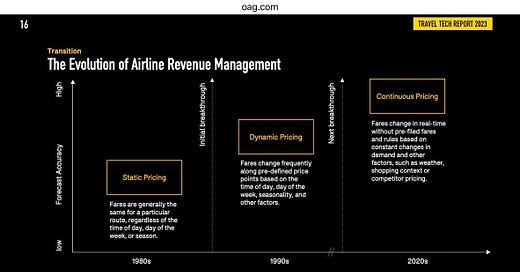Revolutionizing Airline Revenue Management: The Impact of Continuous Pricing with AI
In today's dynamic and competitive airline industry, optimizing revenue management is crucial for carriers to thrive and remain profitable. In the last five years, when I worked for an OTA in Vietnam, specifically Vntrip.vn, we utilized dynamic pricing for airline tickets and hotel rates. However, it's clear that the landscape is evolving. Moreover, it explores how this shift can influence airline revenue management.
The Evolution from Dynamic to Continuous Pricing
Dynamic pricing, often referred to as 'dynamic fare pricing' or 'yield management,' has long been the cornerstone of airline revenue management. It involves setting fares based on a variety of factors, including demand, time until departure, seat availability, and historical data. While dynamic pricing has served the industry well, it has inherent limitations, such as the need for frequent manual adjustments and a somewhat reactive approach.
Continuous pricing, on the other hand, takes revenue management to the next level. This approach is grounded in real-time AI algorithms that continuously adapt fares based on an array of ever-changing variables. AI-driven systems analyze real-time data on demand, competitor pricing, customer preferences, and historical performance, allowing airlines to adjust fares instantaneously.
The Influence of Continuous Pricing on Airline Revenue Management
Real-time Optimization: Continuous pricing enables airlines to adapt their fares to market conditions in real-time. This means they can react instantly to demand fluctuations, changing customer preferences, and competitive pricing strategies. The result is better yield and optimized revenue.
Enhanced Customer Segmentation: AI can segment customers based on various criteria, allowing airlines to tailor pricing and offers to different market segments. This personalized approach can increase revenue by providing attractive offers to specific customer groups.
Pricing Transparency: Continuous pricing promotes pricing transparency, as customers are more likely to see consistent, up-to-date fares. This transparency fosters trust, encouraging customers to book earlier and at higher price points.
Competitive Advantage: Airlines that implement continuous pricing can gain a competitive edge by staying ahead of competitors' pricing strategies. This dynamic approach allows airlines to undercut competitors when necessary while maximizing revenue when demand is strong.
Demand Forecasting: Continuous pricing harnesses the power of AI for precise demand forecasting. The algorithms can adapt to sudden changes in demand, thus preventing overbooking and underpricing.
Seasonal and Event Considerations: Continuous pricing accounts for seasonality and major events, adjusting fares accordingly. This ensures that airlines are well-prepared to maximize revenue during peak times.
Challenges and Considerations
While continuous pricing with AI brings significant benefits, there are challenges and considerations for airlines:
Implementation Costs: Integrating AI-based systems can be costly, and airlines need to invest in the right technology and training for their teams.
Data Security: With the use of AI, airlines must ensure data security and comply with privacy regulations.
Customer Acceptance: Continuous pricing may take time for customers to adapt to, as they are used to more traditional pricing models.
Algorithm Accuracy: The accuracy of AI algorithms is crucial. Inaccurate pricing adjustments can lead to revenue loss or customer dissatisfaction.




